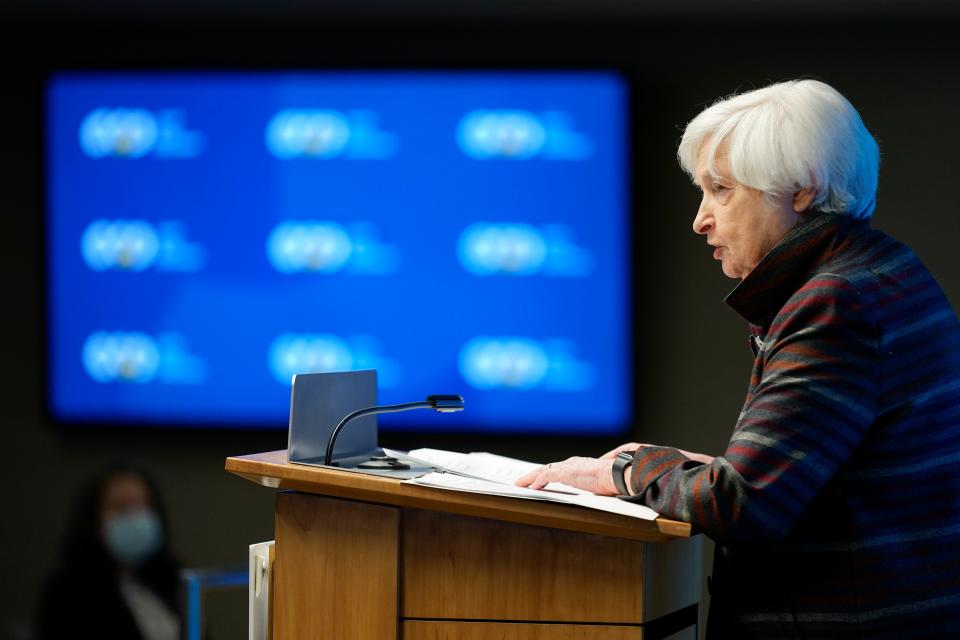Doc’s Prescription: U.S. national debt tops $31 trillion
- Oops!Something went wrong.Please try again later.
The Treasury Department released data on Oct. 4 that showed America’s national debt exceeded $31 trillion for the first time. Our outstanding debt raises major fiscal concerns because low interest costs to fund the debt are being replaced with higher borrowing costs. To combat our high inflation rate, the fastest in 40 years, the Federal Reserve is committed to raising interest rates. The expected growth in interest costs represents a huge threat to Americans’ economic future. According to the Congressional Budget Office, the cost of interest on the national debt will surpass defense spending in 2029, Medicaid, Medicare, and Child Health Insurance in 2046, and Social Security in 2048.

For almost 20 years, the U.S. government has gone on a borrowing spree. The Treasury Department reported that outstanding public debt was $3.3 trillion when President George W. Bush took office in 2001; $10.6 trillion when President Obama took office in 2009; $19.9 trillion when President Trump took office in 2017 and $27.8 trillion when Biden took office in 2021.
The Peterson Foundation tried to put the $31 trillion debt into some perspective. It is more than the value of the economies of China, Japan, Germany and United Kingdom combined. It amounts to $236,000 per household or $93,000 per person in America. Until recently, interest costs have remained low even as the amount of outstanding government debt has climbed sharply. For nearly two years, the Federal Open Market Committee kept the federal funds rate target range near zero. Currently, the federal funds rate is 3.00% to 3.25%. It is expected to rise to 4.5% over the next year.

The Congressional Budget Office projects that interest costs will soon be the fastest-growing category in the federal budget. Interest costs will total $8.1 trillion over the next decade. Such costs will crowd out the nation’s ability to invest in other programs that are vital to our future — education, transportation, climate control, infrastructure and military preparedness.
Putting it into perspective: The national debt is now more than $31 trillion. What does that mean?
U.S. National Debt by Year: How the Debt Compares to GDP, Plus Major Events That Impacted It
Doc’s Prescription: CPI figures indicate inflation will remain a problem for some time
While the coronavirus pandemic accelerated our fiscal challenges, we were already on an unsustainable path. The imbalance between spending and revenues will remain even after the effects of the pandemic have faded. The CBO projects that federal spending will climb from 23.8% of gross domestic product (GDP) in 2022 to 30.2% by 2052. The growth in debt is primarily caused by a growth in spending on health care and retirement programs for elderly Americans, along with rapidly growing interest costs.
America’s health care system has led to an unsustainable fiscal future. In 2020 the United States spent $4.1 trillion on health care, some 20% of our national economy. U.S. per capita health care costs ($12,818 per person) are over twice the average of other wealthy countries. Because we have an aging population, more Americans will qualify for federal health care programs like Medicare.

The U.S. Census Bureau estimates that over the next 30 years, the number of Americans over the age of 65 will increase faster than the working-age population. Our aging demographics will add financial stress to Social Security and Medicare.
• The number of people over 65 will increase by nearly 27 million.
• The number of working-age population will increase by only 22 million.
• The number of people aged 85 and older is expected to triple over the next 30 years.
Older people on average need more health care.
Michael Peterson, the chief executive officer of the Peter G. Peterson Foundation, highlighted our fiscal problems. He said, “So many of the concerns we have had about our growing debt path are starting to show themselves as we both grow our debt and grow our rates of interest. For too long, policymakers have assumed perpetually low interest rates, and we are now seeing in real time how dangerous that assumption is.”
Sarasota resident Ernest “Doc” Werlin spent 35 years in fixed income as a trader and corporate bond salesman, including time as a partner at MorganStanley in charge of corporate bond trading. Send suggestions and comments to ernestwerlin@gmail.com or visit docwerlin.com.
This article originally appeared on Sarasota Herald-Tribune: Record national debt – $31 trillion – raises major fiscal concerns

